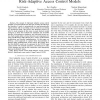96 search results - page 3 / 20 » The role of secondary attributes in formal object modelling |
CCECE
2006
IEEE
13 years 11 months ago
2006
IEEE
Recent experimental evidences have shown that ribonucleic acid (RNA) plays a greater role in the cell than previously thought. An ensemble of RNA sequences believed to contain sig...
ICCS
2007
Springer
13 years 11 months ago
2007
Springer
Abstract. Frames, i.e., recursive attribute-value structures, are a general format for the decomposition of lexical concepts. Attributes assign unique values to objects and thus de...
ACSAC
2008
IEEE
13 years 11 months ago
2008
IEEE
Role hierarchies are fundamental to the role based access control (RBAC) model. The notion of role hierarchy is a well understood concept that allows senior roles to inherit the p...
ARESEC
2011
12 years 5 months ago
2011
—The concept of risk-based adaptive access control (RAdAC, pronounced Raid-ack) has been recently introduced in the literature. It seeks to automatically (or semi-automatically) ...
ECOOP
2009
Springer
14 years 5 months ago
2009
Springer
Role-based access control (RBAC) is a common paradigm to ensure that users have sufficient rights to perform various system operations. In many cases though, traditional RBAC does ...

